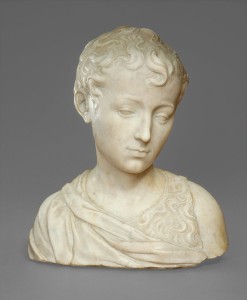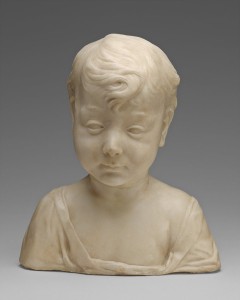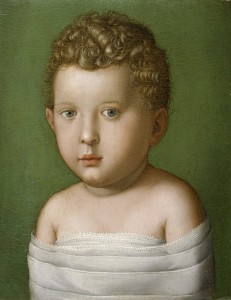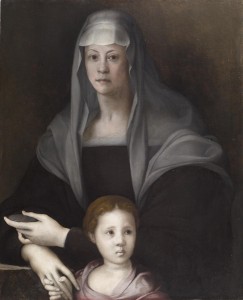![Workshop of Apollonio di Giovanni<br /><i>Triumph of Chastity</i> [obverse], c. 1450–60<br />Tempera and gold leaf on panel, 58.4 x 59.1 cm (23 x 23 1/4 in.)<br />North Carolina Museum of Art, Raleigh, Gift of the Samuel H. Kress Foundation](http://italianrenaissanceresources.com/wp-content/uploads/2013/02/RP_259-300x291.jpg)
Workshop of Apollonio di Giovanni
Triumph of Chastity [obverse], c. 1450–60
Tempera and gold leaf on panel, 58.4 x 59.1 cm (23 x 23 1/4 in.)
North Carolina Museum of Art, Raleigh, Gift of the Samuel H. Kress Foundation
The front of this birth tray, made in the prolific shop of Apollonio di Giovanni (see Models for the bride), depicts the triumph of Chastity, an image derived from Petrarch’s I Trifoni. The poem, also a popular source for cassone and spalliera decorations, describes six triumphal processions the poet witnessed during a spiritual journey. They progress from the triumph of Love, to which all men succumb, through the triumphs of Chastity, Death, Fame, and Time, finally to the triumph of Faith, which prevails over all. The strong iconographic tradition that developed to depict the various triumphs—despite Petrarch’s lack of visual description—drew, at least in part, from the real processions that were enacted in Renaissance Italy during Carnival and other festivals and by the triumphal parades staged by cities for the entry of illustrious persons.
![Workshop of Apollonio di Giovanni<br /><i>Putt</i>i [reverse of <i>Triumph of Chastity</i>], c. 1450–60<br />Tempera and gold leaf on panel, 58.4 x 59.1 cm (23 x 23 1/4 in.)<br />North Carolina Museum of Art, Raleigh, Gift of the Samuel H. Kress Foundation](http://italianrenaissanceresources.com/wp-content/uploads/2013/02/RP_260-300x294.jpg)
Workshop of Apollonio di Giovanni
Putti [reverse of Triumph of Chastity], c. 1450–60
Tempera and gold leaf on panel, 58.4 x 59.1 cm (23 x 23 1/4 in.)
North Carolina Museum of Art, Raleigh, Gift of the Samuel H. Kress Foundation
On the tray’s reverse we see two nude baby boys. Here is the desired result of a Renaissance wedding and birth: male offspring. One of the boys brandishes two poppy-seed pods, pressing one close to the second boy who urinates into (or over) it. The pods, filled with seeds, were commonly understood symbols of fertility. Other trays have similar urinating boys, no doubt suggesting the father’s fertility and the male offspring’s own future role in carrying on the family line.
Painted in the field over the boys’ heads on this tray are three coats of arms. Two would have been more common: those of the mother and father’s families. All of the shields on the tray were repainted during the Renaissance, probably suggesting that multiple owners modified it to reflect changing family situations.

Antonio Rossellino
The Young Saint John the Baptist, c. 1470
Marble, 34.7 x 29.8 x 16.1 cm (13 5/8 x 11 3/4 x 6 1/4 in.)
National Gallery of Art, Washington, DC, Samuel H. Kress Collection
Image courtesy of the Board of Trustees, National Gallery of Art
2. Sculpted busts of boys
Busts of young boys, most in marble, became something of a specialty for Florentine sculptors from about 1450 until the end of the fifteenth century. They are among the first works since antiquity to portray children as children, not as miniature adults. Even in Roman times, most children’s portraits were made for funerary or ancestral display, but these Florentine boys—and they are all boys—are full of life and promise for the future. They speak to a new appreciation of childhood as a unique and separate stage of life and to the hopes of their families and their city. Cessation of the busts’ production coincided with the waning days of republican Florence.
Some of the sculptures (perhaps most) were based on the features of actual children, yet also idealized: they represent childhood in general as much as specific children. Others may have been purely imagined. In some sense the busts portray a parent’s hopes for a child. Many, like the boy by Antonio Rossellino, are clothed in the camel-fur robes of John the Baptist, patron saint of Florence. Depicted on the verge of adolescence, these boys, still modest and vulnerable, project an air of quiet introspection—as if the young saint (and perhaps the real son also) is considering the future. Other busts, typically of younger boys, pudgy with baby fat, were presented as Jesus.
In either case, the busts were made to be displayed in homes and to exert a moral influence over the young children who would have seen them every day. Florentine parents saw them as a means to shape their sons’ character by virtuous example. At the same time, a portrait of a young son, at his most beautiful and best behaved, also represented the promise of continuity for the family and the republic.

Desiderio da Settignano
The Christ Child (?), c. 1460
Marble, 30.5 x 26.5 x 16.3 cm (12 x 10 3/8 x 6 3/8 in.)
National Gallery of Art, Washington, DC, Samuel H. Kress Collection
Image courtesy of the Board of Trustees, National Gallery of Art
The boy carved by Desiderio da Settignano is at once serious and barely able to repress a smile. In one moment he appears alert and impish, in the next full of a somber insight beyond his years. The tilt of the head seems alternately mischievous and pensive. The downcast eyes and inclined head of Rossellino’s Baptist, together with the high arch of his brows, suggest contemplation. Even his leaner face, no longer plumped by infancy, gives the bust a more ascetic and serious character. Its cool, perfect forms recall classical sculpture.
From sometime before 1756 until 1940, the two busts were set above opposite doorways next to the high altar in the Oratory of S. Francesco in Florence. The back of each was flattened for attachment to the wall, and small holes were drilled in the crown of the head to receive a metal halo. These adjustments add support to the idea that Desiderio’s boy was intended to be an image of the Christ Child. The ambivalence of his expression would, in that case, recall for viewers his future sacrifice. It is equally possible, however, that the bust originated as a portrait and was given sacred identity at a later date.

Attributed to Agnolo Bronzino
Portrait of a Baby, 1540–49
Oil on panel, 33.5 x 26 cm (13 1/4 x 10 1/4 in.)
The Walters Art Museum, Baltimore
3. In swaddling clothes
Few independent portraits of infants survive from the Renaissance; this is one of the earliest known. For a long time it was assumed to depict a boy—almost without question a son, not a daughter—of the Medici family for whom Agnolo Bronzino worked. Now, however, some scholars question whether Bronzino or someone else in his circle was the artist, making the boy’s identification as a Medici prince also less secure (in any case, no consensus of which Medici child he might have been had ever been reached).
Just as parents today exchange baby photos with family and friends and keep them in wallets or cell phones, Renaissance families commissioned portraits of their newborns. Not only were they images for the parents to cherish, but they could also be shared with relatives to introduce a new family member—and to show the offspring to be healthy and thriving. Some seventy years before this painting was made, Bernardo Bembo (see below) ordered a portrait of his second son soon after the birth to take with him to Burgundy, where he was serving as an ambassador. When Francesco I de’ Medici received a portrait of a new grandson (his namesake) in 1581, he wrote that the boy was “fat and large and bouncing.”10 Many more portraits of infants and young children must have been made than survive today.
“When I look at [the children], I think them so many angels, and when I listen to them, they seem to be spirits from heaven.”
—Bronzino, while painting portraits of four of the children of Cosimo I de’ Medici in 1551)9
Children, both boys and girls, were wrapped in swaddling until around their first birthdays; it was thought to protect their limbs and promote strong growth. The multiple layers of cloth—wound separately top and bottom to facilitate changing—meant the baby could be propped upright to observe the comings and goings of the household and start to be a part of family life even before he or she could sit or stand.

Jacopo da Pontormo
Maria Salviati and Guilia de’ Medici, c. 1538
Oil on panel, 88 x 71.3 cm (34 5/8 x 28 1/16 in.)
The Walters Art Museum, Baltimore
4. Vulnerability and responsibility
These two paintings show children in positions of vulnerability and responsibility, and reveal different Renaissance expectations about the characters of girls and boys.
In Jacopo da Pontormo’s portrait, Maria Salviati, a granddaughter of Lorenzo de’ Medici, wears the somber clothing and veil of a widow. For many years it was thought that the child with her was her son, Cosimo I de’ Medici, who became grand duke of Tuscany in 1537. Cosimo, however, was probably too old at the time Pontormo made the portrait to have been the child in the painting, who is much more likely to be a girl. She is probably Giulia de’ Medici, a relative who was left in Maria’s care after the murder of the child’s father, Duke Alessandro de’ Medici.
The conventions of Renaissance portraiture—and gender roles of the period—would have a boy appear more forthright, less timid. The girl here looks anxiously away from the viewer, exhibiting none of the engagement expected from a boy who, despite his young years, would be required to project a more active, public persona. The girl’s vulnerability is emphasized by the fact that Maria holds her hand and, even more, by the soft pale skin of her bare neck. (The older woman’s neck is similarly bare, further evidence that the child is likewise female.) It is also unlikely that Pontormo would have positioned Maria in such a protective posture—her massive form seems to provide shelter—if the child were a son destined to assume a position of power and strength.

Titian
Ranuccio Farnese, 1542
Oil on canvas, 89.7 x 73.6 cm (35 5/16 x 29 in.)
National Gallery of Art, Washington, DC, Samuel H. Kress Collection
Image courtesy of the Board of Trustees, National Gallery of Art
Giulia’s father was the son of a Medici cardinal and a servant woman who was said to have been African. If so, this formal portrait may be the first ever made of a girl of African ancestry in the whole of European art. She was entirely painted over sometime during the nineteenth century, reemerging only during cleaning of the work in 1937.
Titian, who was a master of the Renaissance and known as a devoted father, has been called the first great portraitist of children, and his image of Ranuccio Farnese is a strong basis for the claim. The circumstances in which it was painted are known from a letter written by the humanist Gian Francesco Leoni to Ranuccio’s older brother, Cardinal Alessandro Farnese. Commissioned as a gift for the boy’s mother, the portrait of twelve-year-old Ranuccio was painted in Venice just after Ranuccio had been made prior (religious director) of S. Giovanni dei Forlani, an important property belonging to the Knights of Malta. The grandson of Pope Paul III, Ranuccio was the youngest member of one of the wealthiest and most powerful families in Italy. He became cardinal of Santa Lucia in Sicily at the age of fifteen and was named bishop in several important cities before his early death at thirty-five.
Here he is engulfed by a black cloak emblazoned with the Maltese cross. It is the emblem of his new office, and the garment’s enormity conveys his new adult responsibility, still a bit too large for his tender years. The glove he holds and the sword at his hip are likewise hints of his future status, but his young face, shy glance, and delicate ears convey youth and vulnerability under the obligations and rank he has just assumed. Dramatic lighting underscores the contrast, his face and fine garment emerging from the dark robe and muted background. Here is a perceptive picture of the modesty and promise of a sensitive boy about to embark on adulthood and a distinguished public life.